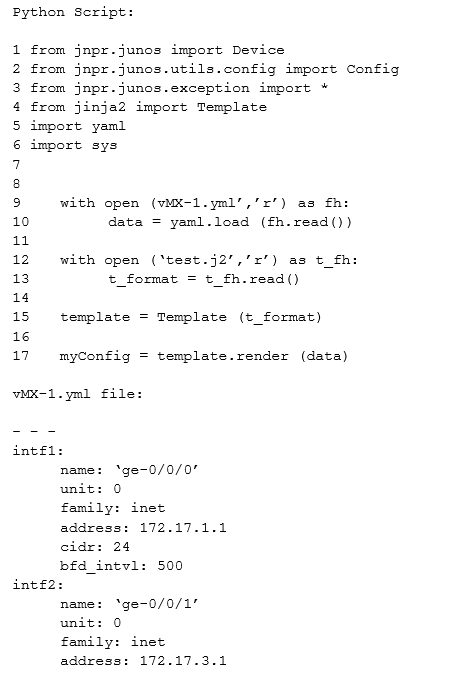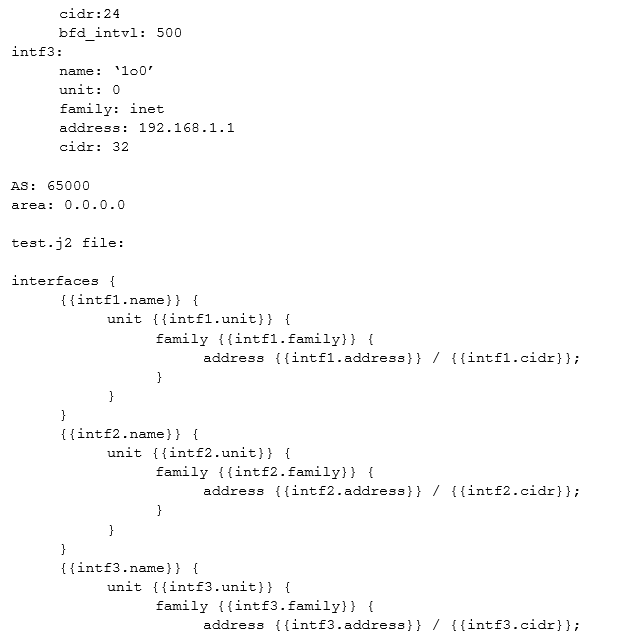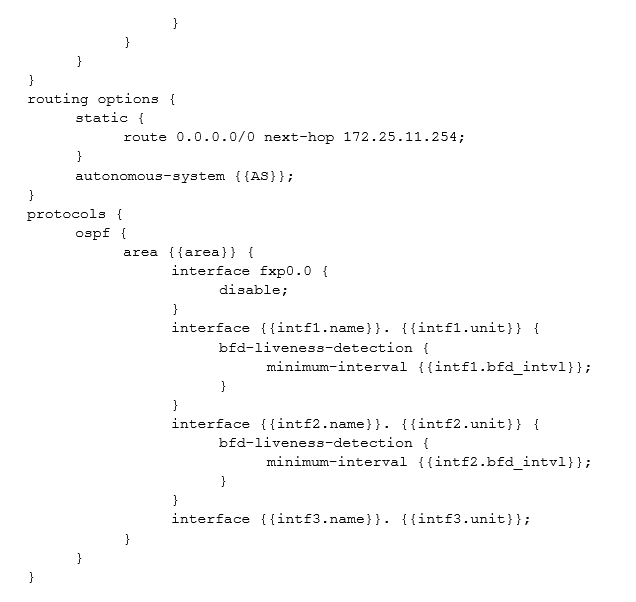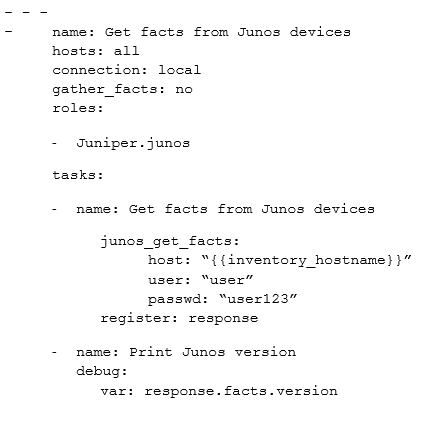Juniper JN0-420 Exam Practice Questions (P. 4)
- Full Access (65 questions)
- One Year of Premium Access
- Access to one million comments
- Seamless ChatGPT Integration
- Ability to download PDF files
- Anki Flashcard files for revision
- No Captcha & No AdSense
- Advanced Exam Configuration
Question #16
What are three ways for PyEZ to connect to supported Junos devices? (Choose three)
- ANETCONF over SSH
- Bserial interface
- CTelnet
- DJET API
- EWebhook
Correct Answer:
ABC
Reference: https://www.juniper.net/documentation/en_US/junos-pyez/topics/task/program/junos-pyez-connection-methods.html
ABC
Reference: https://www.juniper.net/documentation/en_US/junos-pyez/topics/task/program/junos-pyez-connection-methods.html
send
light_mode
delete
Question #17
Click the Exhibit button.
Exhibit:



Referring to the exhibit, what is the type of the myConfig variable on line 17 of the Python script?
Exhibit:



Referring to the exhibit, what is the type of the myConfig variable on line 17 of the Python script?
- Atemplate
- Bdictionary
- Cstring
- Dlist
Correct Answer:
A
Reference: https://www.juniper.net/documentation/en_US/cso3.1/topics/task/operational/cd-config-template-working-config-designing.html
A
Reference: https://www.juniper.net/documentation/en_US/cso3.1/topics/task/operational/cd-config-template-working-config-designing.html
send
light_mode
delete
Question #18
The <rpc-reply> XML tag is a member of which NETCONF protocol layer?
- ATransport
- BContent
- CMessages
- DOperations
Correct Answer:
A
The NETCONF protocol uses an RPC-based communication model. NETCONF peers use <rpc> and <rpc-reply> elements to provide transport-protocol- independent framing of NETCONF requests and responses.
Reference: https://tools.ietf.org/html/rfc6241
A
The NETCONF protocol uses an RPC-based communication model. NETCONF peers use <rpc> and <rpc-reply> elements to provide transport-protocol- independent framing of NETCONF requests and responses.
Reference: https://tools.ietf.org/html/rfc6241
send
light_mode
delete
Question #19
Click the Exhibit button.
Exhibit:

The Ansible playbook shown in the exhibit is executed against a set of Junos network devices. Each Junos device is configured with a user account in the login class. The user account uses SSH-key-based authentication with a passphrase of user123. super-user
What is the result of executing this playbook against the Junos network devices?
Exhibit:

The Ansible playbook shown in the exhibit is executed against a set of Junos network devices. Each Junos device is configured with a user account in the login class. The user account uses SSH-key-based authentication with a passphrase of user123. super-user
What is the result of executing this playbook against the Junos network devices?
- AThe playbook executes, but fails with a "ConnectAuthError" due to the missing passphrase argument to the junos_get_facts module
- BThe playbook fails due to a YAML syntax error.
- CThe playbook executes and prints the version of Junos running on each network device as the value of response.facts.version
- DThe playbook executes and prints "VARIABLE IS NOT DEFINED!" as the value response.facts.version
Correct Answer:
C
C
send
light_mode
delete
Question #20
Which statement is true about a Junos ephemeral configuration database?
- AIt can be used to trigger a commit script
- BIt can be used to reduce commit time
- CIt can be used to archive previous versions of the ephemeral configuration
- DIt can be used to validate configuration data semantics
Correct Answer:
B
Reference: https://www.juniper.net/documentation/en_US/junos/topics/concept/ephemeral-configuration-database-overview.html
B
Reference: https://www.juniper.net/documentation/en_US/junos/topics/concept/ephemeral-configuration-database-overview.html
send
light_mode
delete
All Pages
